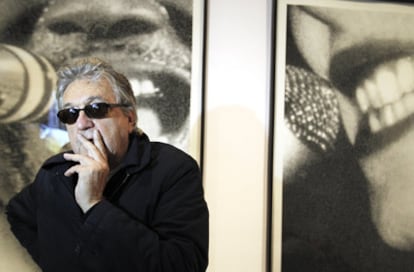Muntadas: An unintentional pioneer
Reina Sofía exhibition shows a creator ahead of his time in the use of new media
Sometimes, it is not really necessary to start at the beginning. Such is the case with the Antoni Muntadas exhibition that opened on November 23 at the Reina Sofía museum in Madrid. The Barcelona artist himself notes that visitors may enter the show through three different doors, mapping different routes of a retrospective that covers the last four decades of work by an essential figure of contemporary art.
In fact, museum organizers positively tried to avoid the "conductivism" and "chronology" inherent in a show of this nature, and instead structured it into "constellations" that bring together pieces that were sometimes made decades apart, to show "that you never close the door, that you leave a possibility open."
In one case, Muntadas' installation at the 1972 Encuentros de Pamplona - a collection of television sets showing commercials inside a dome by the architect Prada Poole - sits side by side with another installation he made in Bogotá in 1999 in which violent images were projected against a clapping audience. Separating both, there is a piece made in 1974, an early attempt at creating a local television station in the Catalan coastal town of Cadaqués during the waning Franco years, when the state had a monopoly on broadcasting.
"Imagine people's faces, at a time of a single TV station, when they walked into a bar and saw a different TV," he recalls. The experiment ended with a telegram from the Ministry of Information forcing the new station to shut down.
His early flirtation with the media made people talk about the 71-year-old Muntadas as a pioneer: a pioneer of conceptual art, of video art, and of net art. But he shrugs off the labels: "I use the necessary media for each project. The fact that some of them barely existed at the time is just anecdotal."
Power, the media, the show factor, translation and the art system are just some of the issues explored by an exhibition that the artist titled, enigmatically, Entre (or, Between). "I used many dichotomies - private versus public, subjective versus objective, history versus the present. And it's not all black and white, but shades of gray."
It is not surprising that his work is crossed by a question: What are you looking at? And by a warning: Attention - perception requires participation. "The media landscape is public, but the answer must be personal," says Muntadas. "People have to defend themselves, and information is a means of defense. Art is perception and information, it processes information and creates esthetic situations that are sometimes ethical. Beauty depends on the raw nerve it touches."
Antoni Muntadas, who has split his time between New York and Barcelona since 1971, describes his work method as more akin to an architect's or a film director's than to "an artistic genius working alone in his studio." Rewarded with a multitude of honors, including the Velázquez Award in 2009, he is "aware" that a national museum is a tool of power, yet he is not afraid that the critical dimension of his work will end up being domesticated.
"I'm aware, yes. The museum places limits, and your work can get de-activated, but you're running the risk. That is why I keep my distance and let the curator and the institutional team formalize all this. I already formalized it back in the day. What the museum does is offer a translation of it. And all translations involve certain things, from interpretation to censorship, which is a perverse translation, although it is not the case here. That is why I named by show at the Macba On Translation Museum."

Tu suscripción se está usando en otro dispositivo
¿Quieres añadir otro usuario a tu suscripción?
Si continúas leyendo en este dispositivo, no se podrá leer en el otro.
FlechaTu suscripción se está usando en otro dispositivo y solo puedes acceder a EL PAÍS desde un dispositivo a la vez.
Si quieres compartir tu cuenta, cambia tu suscripción a la modalidad Premium, así podrás añadir otro usuario. Cada uno accederá con su propia cuenta de email, lo que os permitirá personalizar vuestra experiencia en EL PAÍS.
¿Tienes una suscripción de empresa? Accede aquí para contratar más cuentas.
En el caso de no saber quién está usando tu cuenta, te recomendamos cambiar tu contraseña aquí.
Si decides continuar compartiendo tu cuenta, este mensaje se mostrará en tu dispositivo y en el de la otra persona que está usando tu cuenta de forma indefinida, afectando a tu experiencia de lectura. Puedes consultar aquí los términos y condiciones de la suscripción digital.
Últimas noticias
Pinochet’s victims grapple with José Antonio Kast’s rise in Chile
Reinhard Genzel, Nobel laureate in physics: ‘One-minute videos will never give you the truth’
From digital curfews to blocking apps: How technology experts protect their children online
Why the price of coffee has skyrocketed: from Brazilian plantations to specialty coffee houses
Most viewed
- Pablo Escobar’s hippos: A serious environmental problem, 40 years on
- Why we lost the habit of sleeping in two segments and how that changed our sense of time
- Trump’s obsession with putting his name on everything is unprecedented in the United States
- Charles Dubouloz, mountaineering star, retires at 36 with a farewell tour inspired by Walter Bonatti
- The Florida Keys tourist paradise is besieged by immigration agents: ‘We’ve never seen anything like this’








































